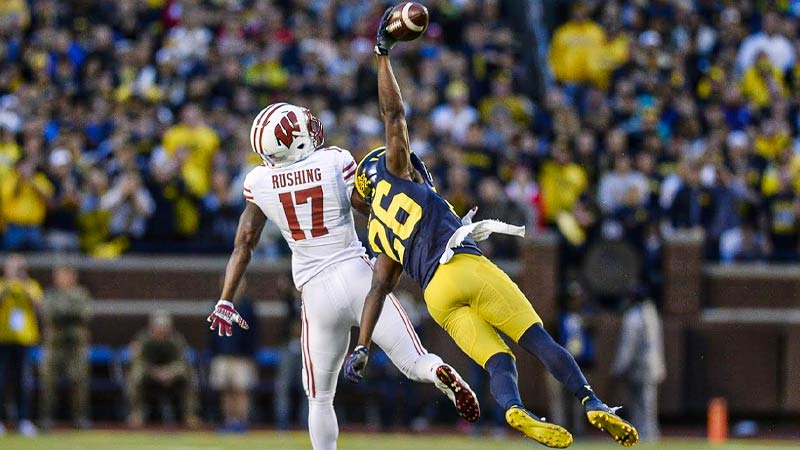In American football, an interception stands as a pivotal and electrifying moment, akin to a well-executed touchdown pass or a bone-crushing tackle. It’s a defensive triumph, a game-altering maneuver that can turn the tide of a match in an instant.
An interception occurs when a vigilant defensive player seizes control of the game by plucking the football out of the air, and snatching it away from the opposition’s intended receiver.
This interception not only halts the offensive drive but also sparks jubilation among the defenders and their fans.
It’s a testament to skill, strategy, and split-second decision-making, often reshaping the course of the game and embodying the essence of American football’s electrifying drama.
The Definition of Interception in American Football
An interception in American football is a critical defensive play that occurs when a defensive player catches a pass thrown by the opposing team’s quarterback, effectively ending the offensive possession and giving possession of the ball to the defense.
This is a momentous event in a football game, often turning the tide in favor of the intercepting team.
Here’s a breakdown of the key elements and aspects of an interception in American football:
Defensive Player’s Role
Interceptions are typically made by defensive backs, such as cornerbacks and safeties, or occasionally by linebackers or defensive linemen who drop back into pass coverage.
These players are tasked with reading the quarterback’s intentions, positioning themselves well, and reacting quickly to make an interception.
Quarterback’s Throw
To complete a pass, the quarterback attempts to throw the ball accurately to one of his receivers downfield.
The defensive player’s goal is to disrupt this connection by getting between the intended receiver and the ball or by making a play on the ball as it’s in the air.
Catching the Ball
When the defensive player successfully catches the football, it’s considered an interception. This requires good hand-eye coordination, timing, and anticipation.
Intercepted passes can vary in terms of height, speed, and trajectory, making the catch a challenging feat.
Possession Change
Once the interception is made, the defensive team takes over possession of the football at the spot where the interception occurred.
This sudden change of possession can be a pivotal moment in the game, often swinging momentum in favor of the defending team.
Return Yardage
In some cases, the player who intercepts the pass may attempt to return the ball for additional yardage.
This is known as an interception return and can lead to an even more favorable field position for the defensive team.
Defensive players who excel at returning interceptions for substantial yardage are often referred to as “ballhawks.”
Strategic Implications
Interceptions are strategically crucial, as they can drastically alter the course of a game. They provide the defensive team with a golden opportunity to score, reset the field position, or simply thwart the opposing team’s offensive drive.
As a result, quarterbacks must be cautious when attempting passes, especially in the presence of skilled defensive backs.
Celebration and Fanfare
Interceptions are celebrated enthusiastically by the defensive players and their fans. They are often accompanied by exuberant celebrations, such as players leaping into the air, dancing, or showcasing choreographed moves. Interceptions are not only exciting but also a source of pride for the defense.
Types of Interceptions in American Football
Interceptions in American football come in various types, each showcasing different skills and scenarios. These types of interceptions highlight the versatility and athleticism of defensive players.
Here are the common types of interceptions:
Tip Drill
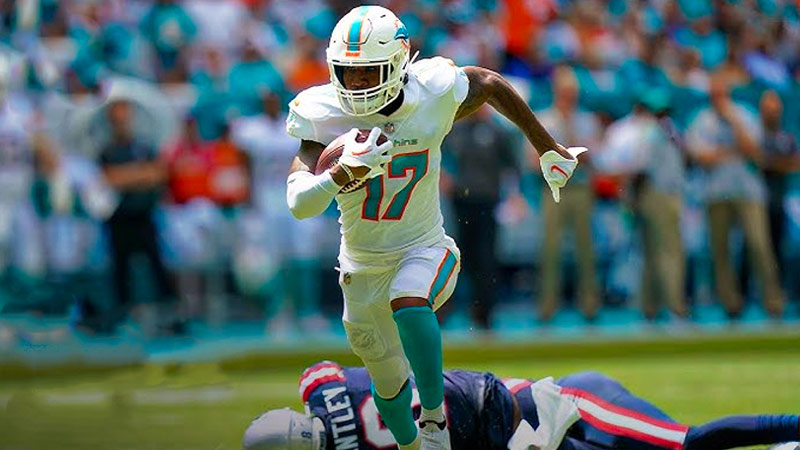
In a tip drill interception, the initial pass from the quarterback is deflected, either by a defensive player or an offensive player, and the ball remains in the air.
Another defensive player, often a teammate, then catches the deflected ball before it hits the ground. This type of interception requires quick reflexes and awareness to track the ball’s trajectory.
Jump Ball
A jump ball interception occurs when a defensive player out-leaps the intended receiver to catch a high pass.
This often happens in the end zone or along the sidelines when the quarterback attempts to throw a pass to a tall receiver or in a one-on-one matchup.
The defensive player must have good timing and leaping ability to make this type of interception.
Over-the-Shoulder
An over-the-shoulder interception happens when a defensive player turns and runs with a receiver down the field, looking back over their shoulder to locate the ball.
They must track the pass and make an acrobatic catch while maintaining coverage on the receiver. This type of interception is common on deep throws.
One-Handed
One-handed interceptions are some of the most visually impressive interceptions. In this type, a defensive player uses only one hand to snatch the ball out of the air. These catches require exceptional hand-eye coordination and athleticism.
Undercut
An undercut interception occurs when a defensive player reads the quarterback’s eyes and anticipates the pass, positioning themselves to intercept the ball before it reaches the intended receiver.
This often happens when the defensive player recognizes the route and makes a calculated gamble to jump the route.
Diving
A diving interception happens when a defensive player lays out and extends their body horizontally to make a catch, often just inches above the ground.
These interceptions are a testament to a player’s determination and athleticism, as they sacrifice their body to secure the interception.
Screen Pass
In a screen pass interception, the defensive player identifies and intercepts a pass intended for a running back or receiver on a screen play. This type of interception is often the result of a well-read play and quick reaction time.
Tip and Toe-Tap
This type of interception combines the tip drill with a receiver’s ability to get both feet in bounds along the sideline.
A defensive player may tip the pass while staying in bounds and then manage to tap their toes inbounds before falling out of bounds, securing the interception.
Red Zone
Red zone interceptions occur in or near the opponent’s end zone. These interceptions are crucial because they prevent the opposing team from scoring points and often result in a touchback, giving the defending team possession at the 20-yard line.
Game-Changing
Some interceptions are game-changers, occurring in critical moments when a team is behind or in a tie game. These interceptions can lead to winning drives or defensive touchdowns, making them particularly memorable.
Rules of Interception in American Football
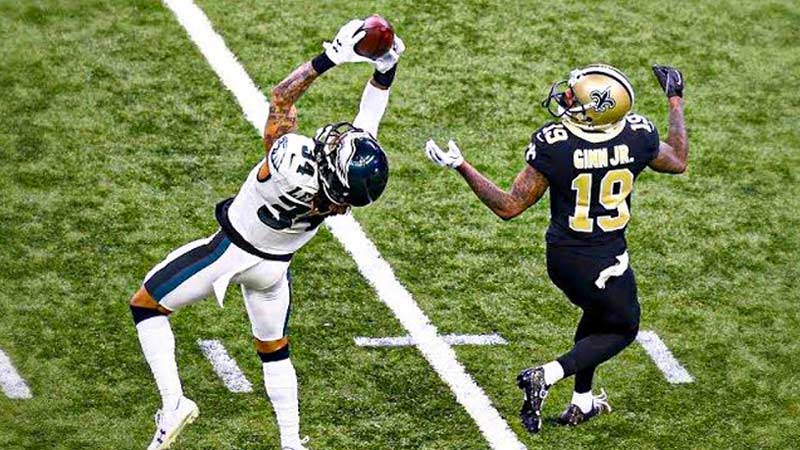
Interceptions in American football follow specific rules outlined by the NFL (National Football League) and other governing bodies. Understanding these rules is crucial for both players and fans.
Here are the key rules governing interceptions in American football:
Legal Catch
To be considered a legal interception, the defensive player must catch the ball cleanly. The ball cannot touch the ground or any other object, such as the defensive player’s body or the opponent’s body, before being secured by the interceptor.
Possession
The defensive player must establish possession of the ball before it is ruled an interception. This means having control of the ball with both feet (or another body part) inbounds, similar to the rules for a receiver catching a pass along the sideline.
Inbounds
The interception must occur with the defensive player’s feet (or another body part, such as a knee or elbow) inbounds.
If any part of the interceptor’s body touches the sideline or goes out of bounds before establishing possession, it’s not considered a valid interception.
Two Feet Down
Typically, in American football, a player must have both feet inbounds to establish possession. However, if the interceptor jumps from out of bounds and catches the ball while in the air before landing with one or both feet inbounds, it can still count as a valid interception.
End Zone
If an interception occurs in the end zone, the defensive player can down the ball by taking a knee, which results in a touchback. This means that the offense gets the ball at their own 20-yard line.
Touchback
If the defensive player intercepts the ball but is tackled in their own end zone or if they voluntarily down the ball in their end zone (without advancing it out of the end zone), it’s a touchback. The ball is placed at the 20-yard line for the offense.
Return
After an interception, the defensive player has the option to attempt a return. They can run with the ball and try to gain additional yardage, potentially setting up their offense with better field position.
However, they must be cautious not to fumble, as this can result in a turnover back to the offense.
Blocking
During an interception return, the defensive player’s teammates can engage in blocking to help clear a path for the returner.
However, they must do so legally, avoiding illegal blocks in the back or other forms of illegal contact.
Change of Possession
Once an interception is confirmed, possession of the ball switches from the offense to the defense. The defensive team’s offense takes the field, usually at the spot where the interception occurred.
Reviewable
In the NFL and some other leagues, interceptions can be subject to video replay review to ensure that the rules for possession, inbounds play, and other factors were correctly applied.
Coaches can challenge the ruling on the field, and the replay officials in the booth may review the play as well.
What Happens When an Interception Is Made?
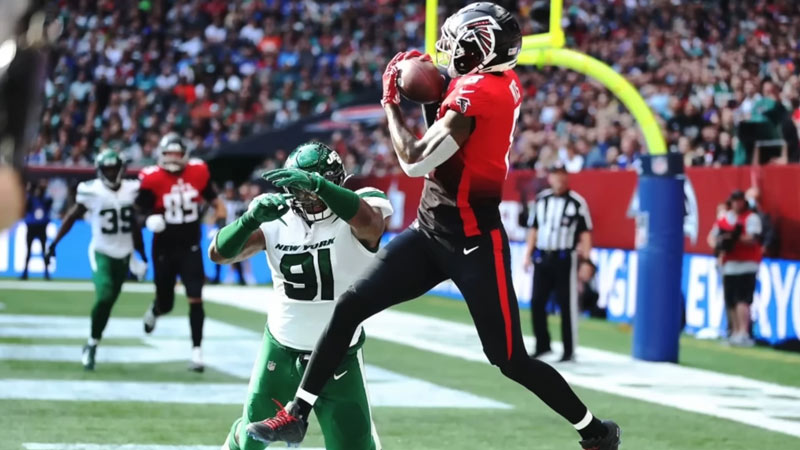
When an interception is made in American football, several specific actions and consequences follow.
Here’s what happens when an interception occurs:
Change of Possession
The most immediate and significant outcome of an interception is the change of possession. The team that was on defense before the interception becomes the offensive team, and the team that was on offense becomes the defensive team.
Spot of the Interception
The new offensive team takes possession of the ball at the spot on the field where the interception was made. This becomes their new line of scrimmage.
Down Count Reset
The new offensive team starts a new set of downs. In American football, a team has four downs (plays) to advance the ball at least ten yards. After an interception, they begin their series of downs again with first down.
Field Position
The field position for the new offensive team is determined by where the interception took place.
If the interception occurs deep in the defensive team’s territory, it can provide an excellent field position for the offense, potentially leading to scoring opportunities.
Touchback
If the interception occurs in the end zone, it is called a touchback. In this case, the ball is placed at the 20-yard line for the offensive team to start their possession.
The touchback rule prevents the defense from advancing the ball out of the end zone and gives the offense a standardized starting point.
Option to Return
The defensive player who made the interception has the option to return the ball by running with it.
If they decide to return the interception, they aim to gain additional yardage before being tackled or going out of bounds. A successful return can improve the offensive team’s field position even further.
Avoiding Fumbles
During the return, the player who intercepted the ball must take care to secure it properly. Fumbling the ball during the return can lead to a turnover, giving possession back to the opposing team.
Celebration
Interceptions are often celebrated enthusiastically by the defensive players and sometimes involve choreographed celebrations or displays of excitement.
A successful interception is a significant achievement in a football game and can be a turning point for the team.
Momentum Shift
Interceptions can have a substantial impact on the momentum of a game. They can swing the momentum in favor of the team that made the interception and deflate the offense’s confidence. They are often considered game-changing plays.
Strategic Considerations
Interceptions can influence a team’s play-calling strategy. The offensive team may become more cautious in their passing game, while the defensive team gains confidence and momentum.
How to Develop Football Players’ Interception Skills
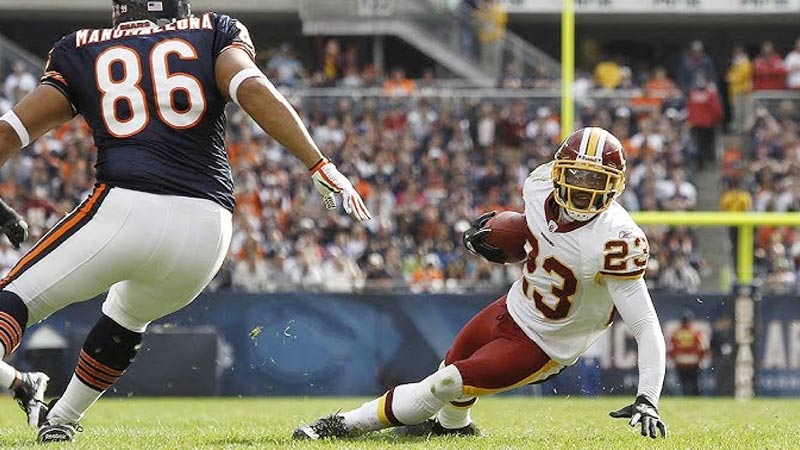
Developing football players’ interception skills requires a combination of coaching, practice, and individual effort.
Interceptions are a valuable defensive asset, and improving these skills can make a significant difference on the field.
Here are steps and tips to help develop interception skills in football players:
Fundamental Coaching
Begin by establishing a strong foundation in fundamental football skills. These include proper stance, footwork, and tackling techniques.
Players should be well-versed in basic coverage principles and understand their roles within the defensive scheme. Sound fundamentals serve as the building blocks for becoming an effective interceptor.
Hand-Eye Coordination
Hand-eye coordination is vital for tracking and catching the ball during interceptions. Incorporate a variety of drills that challenge players to sharpen this skill.
Consider using smaller, more agile balls like tennis balls or reaction balls. These drills not only improve hand-eye coordination but also train players to react swiftly to unexpected situations.
Reaction Time
Developing quick reactions is paramount for intercepting passes. Implement drills that focus on recognizing and reacting to cues, such as the quarterback’s body language or the flight of the ball.
Emphasize the importance of anticipation – getting a jump on the play by reading the quarterback’s intentions before the pass is thrown.
Footwork and Positioning
Proper footwork and positioning are essential for putting players in the right place at the right time. Teach players to maintain optimal coverage positions, keeping their hips low and shoulders square to the line of scrimmage.
Stress the significance of maintaining a cushion between themselves and the receiver while still being in a position to make a play on the ball.
Film Study
Film study can be a game-changer for interception skills. Encourage players to watch game footage, paying close attention to the opposing quarterback’s tendencies, favorite targets, and common situations where interceptions can occur.
This knowledge empowers players to make more informed decisions on the field.
Tracking the Ball
Tracking the ball effectively requires constant practice. Incorporate drills that challenge players to follow the ball’s flight path accurately.
Encourage them to focus on the ball’s rotation and trajectory, which helps in maintaining visual contact during interceptions.
Catching Technique
Catching the ball securely is crucial for interceptions. Teach players proper hand placement and catching techniques.
Emphasize catching the ball at its highest point to gain an advantage over the receiver. Repeatedly practice these techniques to ensure they become second nature.
Simulated Game Situations
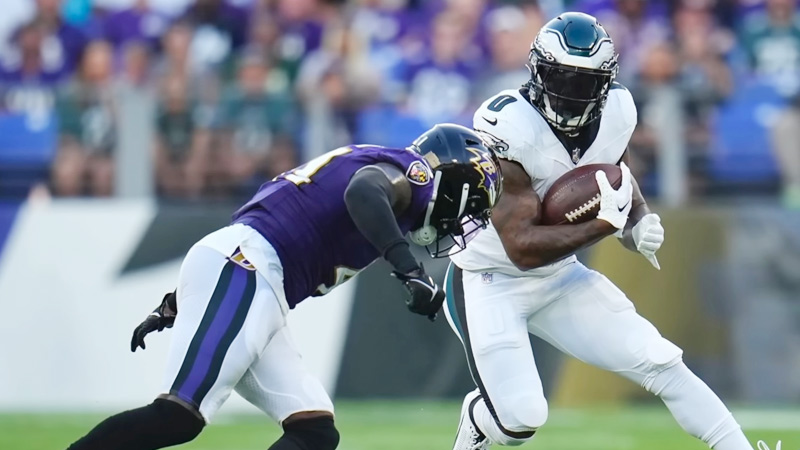
Replicating real-game scenarios in practice is essential. Create one-on-one coverage situations and zone coverage scenarios, allowing players to apply their interception skills in context. These drills should mimic the pace and intensity of actual game situations.
Ball Drills
Ball-focused drills are essential for developing interception skills. Challenge players with diving catches, one-handed grabs, and catches while backpedaling.
Include tip drill exercises, where players practice intercepting deflected passes – a common situation in games.
Competition and Confidence-Building
Foster a competitive environment during practice by having players compete against each other.
Recognize and celebrate their successes to boost their confidence. Constructive feedback is equally important for continuous improvement.
Mental Toughness
Stress the mental aspect of interceptions. Encourage players to stay focused, composed, and confident throughout the game. Help them develop mental toughness to handle the pressure of crucial passing situations.
Game Repetitions
Encourage players to apply what they’ve learned in practice to actual games. The game experience is invaluable for refining interception skills under the pressure of live competition. Players should be encouraged to take calculated risks when opportunities arise.
Continual Improvement
Emphasize the importance of continuous improvement. Encourage players to work on their interception skills year-round, not just during the football season.
Provide access to resources, such as offseason training programs, to help them continually refine their skills.
What Is an Interception in Flag Football?
In flag football, an interception is a defensive play that occurs when a defensive player catches a pass thrown by the opposing team’s quarterback, effectively ending the offensive possession and giving possession of the ball to the defense.
Much like in traditional tackle football, interceptions in flag football are significant game-changing events.
Here’s how an interception works in flag football:
Passing Play
Just as in tackle football, flag football involves passing plays, where the quarterback attempts to throw the ball to one of their receivers downfield.
Defensive Player’s Role
Defensive players, such as cornerbacks or safeties in flag football, aim to read the quarterback’s intentions and position themselves to make an interception. They also need to react quickly to the pass and get between the intended receiver and the ball.
Catching the Flag
Instead of tackling the ball carrier, as in traditional tackle football, defensive players in flag football aim to grab or “pull” the flag belt from the waist of the ball carrier.
An interception occurs when the defensive player successfully grabs the flag belt of the intended receiver while the ball is in the air.
In essence, intercepting a pass in flag football means preventing the receiver from catching the pass by removing their flag belt before they can secure the ball.
Change of Possession
After an interception is made in flag football, the defensive team takes over possession of the ball at the spot where the interception occurred.
The sudden change of possession can be a pivotal moment in the game, often swinging momentum in favor of the defending team.
Return Yardage
Similar to tackle football, in flag football, the player who intercepts the pass has the option to attempt a return, running with the ball to gain additional yardage.
A successful return can provide the defensive team with better field position for their offensive drive.
Celebration and Fanfare
Interceptions in flag football, much like in tackle football, are celebrated with enthusiasm by the defensive players and their fans. They are moments of pride and accomplishment for the defense.
FAQS
Can any player on the defensive team attempt an interception?
No, while interceptions can be made by various defensive players, such as cornerbacks and safeties, any player on the defensive team, including linebackers and defensive linemen, can attempt an interception.
Do interceptions count as turnovers on downs?
No, interceptions do not count as turnovers on downs. A turnover on downs occurs when the offensive team fails to advance the ball ten yards in four downs.
Can a player intercept their own team’s pass?
No, a player cannot intercept their own team’s pass. Interceptions only occur when a defensive player catches a pass thrown by the opposing team’s quarterback.
What’s the record for the most interceptions in a single NFL season?
The NFL record for the most interceptions in a single season is 14, held by Dick “Night Train” Lane in 1952.
Can an interception result in a safety?
Yes, it is possible for an interception to result in a safety. If a player intercepts a pass in their own end zone and is subsequently tackled or goes out of bounds behind the goal line, it is ruled as a safety.
Last Words
In the fast-paced arena of American football, an interception embodies the essence of the game’s intricate strategy and electrifying drama. It is a defensive triumph that transcends mere statistics, often rewriting the narrative of a match in the blink of an eye.
Whether achieved through acrobatic leaps, quick reactions, or strategic anticipation, an interception stands as a testament to the defender’s skill and football IQ.
Beyond the statistics, it symbolizes a pivotal shift in momentum, a rallying cry for the underdogs, and a source of jubilation for the defensive unit and its fervent fans.
In American football, an interception isn’t just a play; it’s a game-altering spectacle that encapsulates the sport’s enduring allure

